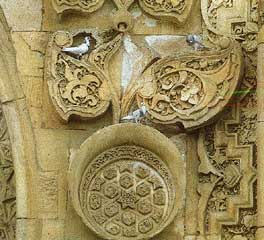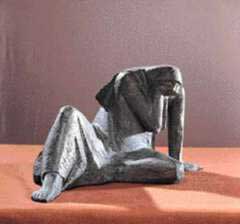|
|
|
SCULPTURE |


Reliefs From the Ulu Mosque, Divrigi During the period of drawing nearer to the West in the cultural sense, that started in the final years of the Ottoman period, there was a revival in the field of sculpture as there was in the other fields of art. The activities were also continued in the Republic period to develop the art of sculpture. Series of archaeological excavations, called "National Excavations", were made in order to unearth the sculptural heritage of former civilizations. Foreign masters in the field who were imported, instructed young talents, and successful students were sent abroad for education. In 1937, German sculptor Rudolf Belling was appointed the chairman of the Department of Sculpture at the State Academy of Fine Arts. Belling who served as a professor at the Academy until 1954 trained many students and continued to produce sculptures. He is the sculptor of the Inonu monuments at the Istanbul Taslik Park and on the campus of the Ankara University's Faculty of Agriculture. One of the most important sculpture exhibitions in Turkey was also realized by Belling at the Taskisla building of the Istanbul Technical University. "Yalnizlik" (Loneliness) by Huseyin Gezer The first period in this field of art, which lasted until the 1950s, in which monuments and sculptures of Atatürk were given priority, was dominated by foreign masters such as Krippel, Canonica, Hanak, Thorak and Belling. However, Turkish sculptors had important successes in the monument competitions which started to be organized as of 1937. For instance, Ali Hadi Bara won the first prize and Zuhtu Muridoglu was placed second in the design competition for the Erzurum Monument , and Nejat Sirel won the first prize in the competition for the Manisa Monument in which foreign sculptors had also taken part. Many of the sculptors who started their professional life in the 1950s, such as Hakki Atamulu, Yavuz Gorey, Kamil Sonad, Ilhan Koman, Huseyin Gezer and Turgut Pura, were the students of Belling. Even those sculptors whose works are mainly figurative have also experimented with figurative-abstract works. However, some of them, namely Ilhan Koman, Sadi Calik and Turgut Pura, produced mainly abstract sculptures. Among them, Ilhan Koman held many exhibitions abroad and won prizes in numerous competitions. Hadi Bara and Zuhtu Muridoglu influenced the Academy's Department of Sculpture after the 1950s. Abstractionist approaches and the use of various contemporary tools and techniques were characteristics of this period. Sculptors such as Tamer Basoglu, Kuzgun Acar, Gurdal Duyar and Namik Denizhan are the main representatives of this school. Kuzgun Acar, who won the first prize at the Paris Youth Biennial in 1961, produced some very interesting abstract sculptures. For instance, Kuslar (The Birds), an iron relief in front of the Istanbul Manifaturacilar Carsisi (Istanbul Textiles Bazaar), is his work. Mehmet Aksoy who brought new dimensions to figurative sculpture, Ferit Ozsen who produced abstract works with metal and stone material, Saim Bugay and Hayri Karay who attracted attention with their woodworks and Metin Haseki, are some of the other noteworthy contemporary sculptors. Atatürk's Promotion of Sculpture Mustafa Kemal Atatürk, founder of the Turkish Republic, gave priority to reforms in education and art so that Turkish art, long influenced by Arab and Persian civilizations and later by the west, would at last create its own original forms. Atatürk believed in the arts as a powerful moral force, essential to the new nation's health. He attached a special significance to the fine arts. After the establishment of the Republic, the following measures were taken to promote sculpture: Architectural studies were expanded under the guidance of the Turkish Historical Association. New discoveries unearthed in the course of excavations expanded the horizons of the sculptors and other artists. Excavations led to the discovery of numerous new archaeological sites in Turkey, some dating back to 8000 B.C. The sites in the Yasemic region are especially compelling in regards to sculpture. Statues in this region bear strong evidence of specialization and a high degree of skill. Workshops dating back to 2000 B.C. in Alacahoyuk, Kalin Kaya, Bogazkoy and Tilmen, excavated by Von der Ostein in1926, indicate a highly developed form of sculpture. Students were sent abroad to foreign sculpturing centres in Paris, Munich, and other cities. First to travel abroad were Ratip Asir, A. Hadi Bara, Zuhtu Muridoglu and Nusret Suman. Simultaneously, the services of foreign sculptors were used. In 1937, Belling came to Turkey to escape from Hitler's Nazi Germany. His students included Huseyin Ozkan, Hakki Atamulu,Yavuz Gorey, Rahmi Artimex, Illan Koman, Zerrin Bolukbasi, Huseyin Geizer, Turgut Pura, Sadi Clik. A more artistic environment was created. 'Art awareness' articles published in various newspapers and magazines increased communication between sculptors and the public and heightened interest in this art form. Atatürk instituted various awards for sculpture and opened new art schools, training institutes, museums, state exhibitions and galleries. |